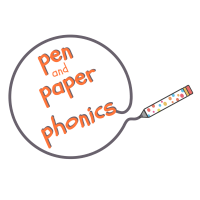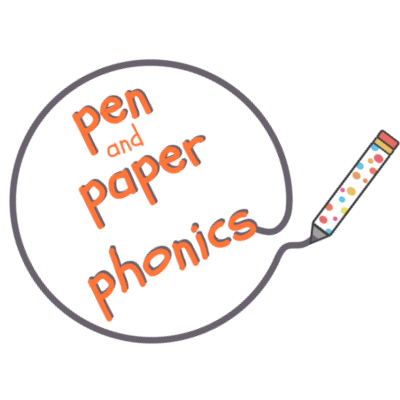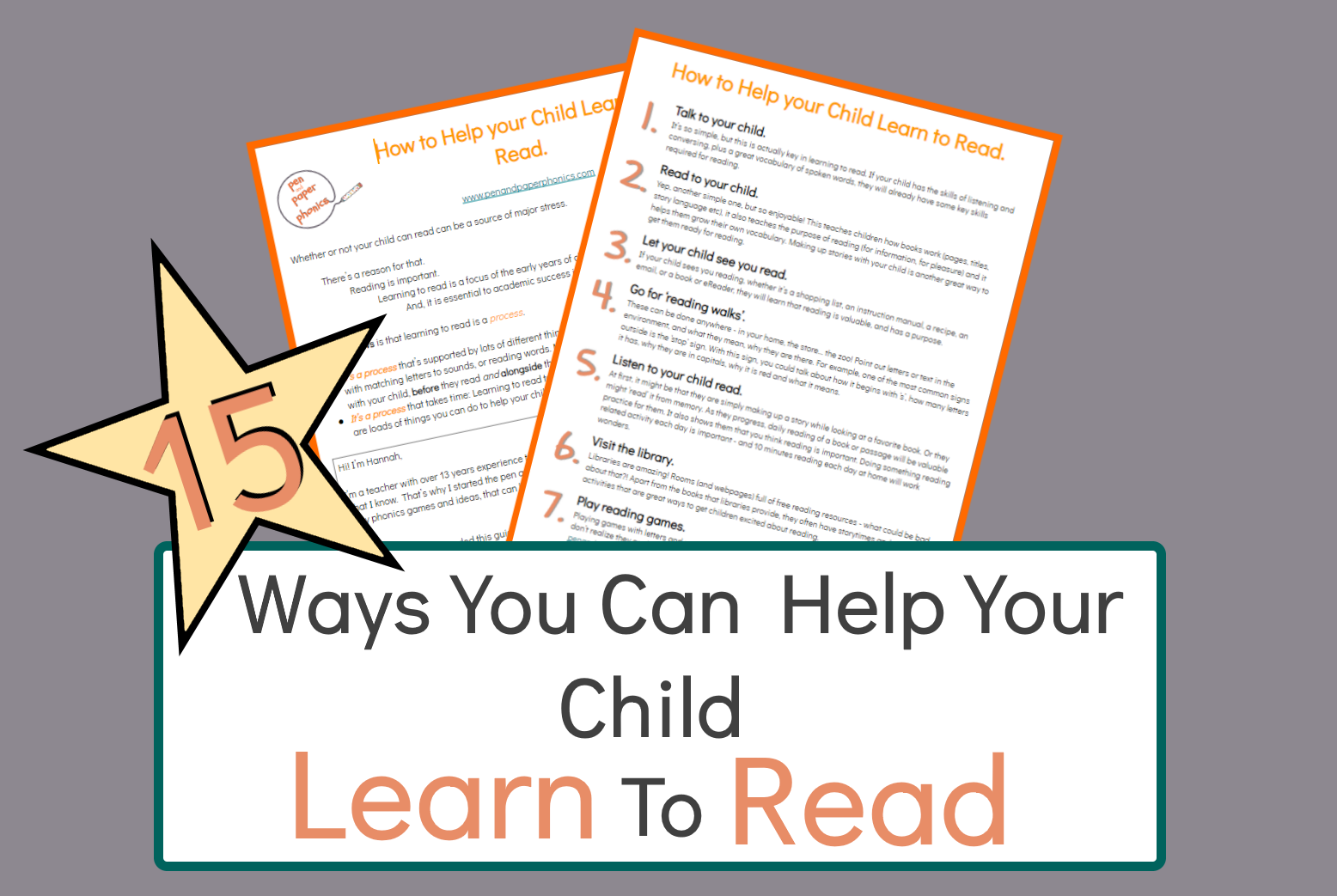A Racetrack.
The Basic Idea:
- A piece of paper. It can be any size but larger is better, such as poster sized or A3.
- Draw a circular racetrack on the paper and separate it into sections.
- Write the words or letter sounds that you want to practice, one in each section.
- You will also need a dice or number spinner.
An example:

The content of the game.
In this example, the content I wanted to practice was ‘letter sounds.’ These are the sounds that the letters in the alphabet most commonly make when they are used in words. For example, the letter ‘a’ in apple makes an /a/ sound.
A note about letter sounds:
The sounds of letters are different from the names of letters. For children to start to read, they need to know the sounds that letters make, they need to start to associate the sound with the letter.
This is the very beginning of reading and is called letter sound correspondence.
Typically children are taught these sounds first: /s/,/a/,/t/,/p/,/i/,/n/. This is because these are common letters/sounds, they are used in a lot of words, and simple words can be made using them, for example, in, it, is, at, tin, pin, tap.
So, in this activity, I wanted to reinforce a few letter sounds we had been learning:
- I only used six letter sounds, and I repeated them often on the race track.
- I used more of the letter sounds that I knew my student was familiar with at the beginning of the track and then used less familiar ones at the end.
- I also repeated the letter sounds a lot so that there was more likelihood of landing on them.
The method of the game.
The method I used to teach the content was a race track.
- This is how to play:
- Line up the cars at the start line.
- Go through all the letter sounds that are on the track.
- Take turns to roll the dice, and move the cars around the track.
- When you land on a section, say the letter sound that you have landed on.
- Congratulate your child when they get the letter sound right, and help them if they get stuck.
- Finish the game by reaching the finish line.
- Repeat the game a few times.
To Note:
Not every game goes to plan! Here are some things to watch out for in this game:
- You might not land on every letter sound. That’s why it is good to repeat the letters on the track so there is more chance of landing on them. Throughout the game, you could also say “We haven’t landed on…” or, “I hope I land on /a/”. Also, repeating the game a few times will mean you are more likely to land on every letter sound.
- This is a game but also a race, and sometimes that leads to frustration when the race is lost! As the aim of the game is to read the letter sounds, rather than to get around as fast a possible, it might be better if you take away the dice and just move one section at a time, reading each sound as you go.
How to Adapt:
…the content:
1. Letter Sounds: Increase the number of sounds on the track, or introduce new sounds.
2. What begins with…: When you land on the letter sound, you could also say a word that begins with that sound. So if you land on /s/, you say the letter sound, and then ‘snake’, or ‘soup’ or ‘sad’. When you do this, it is good to emphasize the sound, so the child can hear it at the beginning of the word, so you could repeat the sound a few times before saying the word (for example s,s,s,s,snake).
When you land on the letter sound, you could also say a word that begins with that sound. So if you land on /s/, you say the letter sound, and then ‘snake’, or ‘soup’ or ‘sad’. When you do this, it is good to emphasize the sound, so the child can hear it at the beginning of the word, so you could repeat the sound a few times before saying the word (for example s,s,s,s,snake).
3. Actions: Similar to the one above, when you land on the letter sound, you could do an action starting with that sound. So for example, if you landed on /s/ you could stand or sit. If you landed on /t/ you could touch your nose. This involves a bit more planning beforehand as you will have to think of actions that begin with the letter sounds that you have chosen.
Similar to the one above, when you land on the letter sound, you could do an action starting with that sound. So for example, if you landed on /s/ you could stand or sit. If you landed on /t/ you could touch your nose. This involves a bit more planning beforehand as you will have to think of actions that begin with the letter sounds that you have chosen.
4. Digraphs (two-letter sounds): As children learn all the letter sounds of the alphabet, they move onto digraphs, or sounds written with two letters, such as /ch/ in chat. You could use two-letter sounds instead of single-letter sounds on your race track.
As children learn all the letter sounds of the alphabet, they move onto digraphs, or sounds written with two letters, such as /ch/ in chat. You could use two-letter sounds instead of single-letter sounds on your race track.
5. Words with a Specific Sound: You could choose just one digraph, for example, and use words that reinforce it. In the case of /ar/ you could use words such as ‘car’, ‘yard’ and ‘star’. Or, you use single letter sounds, such as words with /p/ in them: ‘tap’, ‘pot’, ‘pin’.
You could choose just one digraph, for example, and use words that reinforce it. In the case of /ar/ you could use words such as ‘car’, ‘yard’ and ‘star’. Or, you use single letter sounds, such as words with /p/ in them: ‘tap’, ‘pot’, ‘pin’.
6. Words that Rhyme:  An awareness of rhyme is a very important phonic skill, so using rhyming words would be a great way to reinforce this. You could also put one odd word that does not rhyme to see if your child can hear the difference.
An awareness of rhyme is a very important phonic skill, so using rhyming words would be a great way to reinforce this. You could also put one odd word that does not rhyme to see if your child can hear the difference.
7. Key Words: Key words are words that are used frequently. Therefore it is good if children can learn them by sight. They can be small such as ‘it’, ‘on’, or longer, such as ‘will’, ‘just’, ‘then’. Reinforcing them in a game like this is a good way to help children recall them faster. You could use a selection of common key words or use some words that your child is struggling to read or remember.
Key words are words that are used frequently. Therefore it is good if children can learn them by sight. They can be small such as ‘it’, ‘on’, or longer, such as ‘will’, ‘just’, ‘then’. Reinforcing them in a game like this is a good way to help children recall them faster. You could use a selection of common key words or use some words that your child is struggling to read or remember.
8. Tricky Words:  Tricky words are like key words but they are often characterized by the fact that they cannot be ‘sounded out’. They are irregular words as they do not follow a pattern, for example ‘the’ or ‘said’. Often they can be written in a different color to the rest of the words, as a visual reminder to the child. When they see it they are reminded not to sound it out, but rather just to try to remember it. If you chose this adaptation, then you could write the regular words in one color and then the tricky words in another color.
Tricky words are like key words but they are often characterized by the fact that they cannot be ‘sounded out’. They are irregular words as they do not follow a pattern, for example ‘the’ or ‘said’. Often they can be written in a different color to the rest of the words, as a visual reminder to the child. When they see it they are reminded not to sound it out, but rather just to try to remember it. If you chose this adaptation, then you could write the regular words in one color and then the tricky words in another color.
9. Letter Names and Sounds: If your child is confident with the letter names of the alphabet, it might be good to discuss how the letter name is different from the letter sound. So when you land on the ‘a’, you could say the sound /a/ as in apple, as well as it’s letter name. If your child is not confident on letter sounds or names, then it is best just to stick with the letter sounds.
10. Familiar Letters:  If you wanted your child to learn the letters in their name, you could use these letter sounds. There is an opportunity here for looking at the difference between capital letters and lower case letters. There is also opportunity to discuss how some letters do not always make the same sound. For example ‘i’ in Isaac, does not make the same sounds as the ‘i’ in ‘igloo’. This is a tricky concept, so it might be best left for a later time.
If you wanted your child to learn the letters in their name, you could use these letter sounds. There is an opportunity here for looking at the difference between capital letters and lower case letters. There is also opportunity to discuss how some letters do not always make the same sound. For example ‘i’ in Isaac, does not make the same sounds as the ‘i’ in ‘igloo’. This is a tricky concept, so it might be best left for a later time.
How to Adapt…the method:
- Have a running race: You could use small dolls or people toys, such as lego figures, to have a ‘running’ race, where you move the figures rather than the cars.
- Make it large scale: You could chalk a track outside and write the letter sounds you want to practice. Then roll a dice and jump or run to the sound. Say the letter sound or word when you get to it. If you don’t have a dice you could make it into a race, for example saying “Who can be the first to get to /s/?”
There you have it. A quick and easy phonics activity with lots of potential to adapt to suit your needs. Let me know in the comments how you get on.
This is how it looked when I did it in ‘real life’!




Quick and Easy Phonics Activity Using a Pen and Paper: Sticky Note Word Builders | It can't hurt to try…
[…] introduction to Pen and Paper Phonics as well previous activities (A Roll of Paper and A Racetrack) are also on my […]